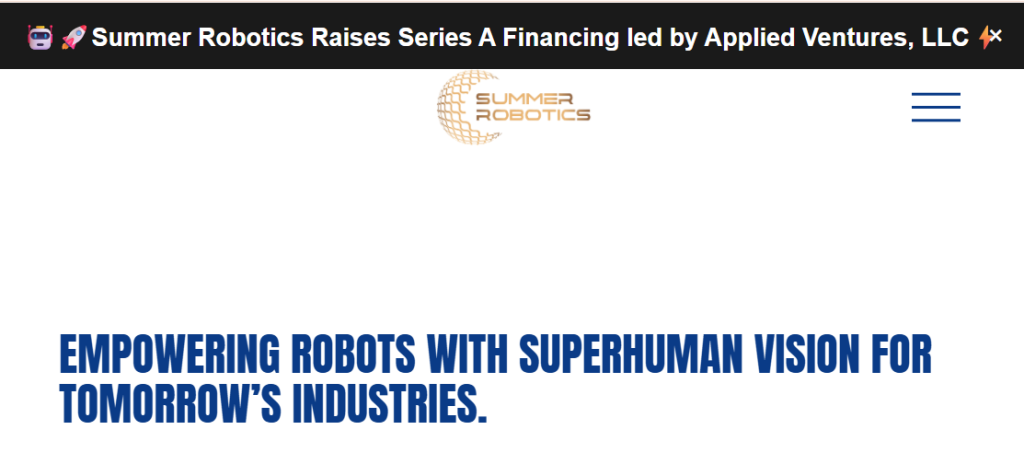
Summer Robotics, a California-based innovator in intelligent automation, has successfully closed its Series A round led by Applied Ventures, Solasta Ventures, NAVER D2SF, and other strategic investors. While the exact amount remains undisclosed, the backing of these highly respected funds signals strong confidence in Summer Robotics’ mission: redefining what’s possible in robotics and automation.
The company, founded by Schuyler Cullen, is operating at the cutting edge of robotic systems that merge hardware excellence with advanced AI-driven software. By aligning machine learning with physical automation, Summer Robotics is targeting sectors where precision, adaptability, and efficiency are paramount - from manufacturing and logistics to emerging fields like healthcare robotics.
Why Investors Are Excited
Applied Ventures, the venture capital arm of Applied Materials, is known for backing transformative technologies with deep industry applications. Solasta Ventures has a history of supporting groundbreaking companies at the intersection of hardware and advanced science, while NAVER D2SF, the startup accelerator arm of Korean tech giant NAVER, brings global scale and platform synergies to the table.
This syndicate of investors represents not only capital but also ecosystem leverage - expertise in scaling advanced technologies, access to supply chains, and introductions to global markets where robotics adoption is accelerating.
From Proof of Concept to Platform
At its core, Summer Robotics is not building just single-function robots - it’s developing an intelligent automation platform. The company’s strategy is to create modular robotics solutions that can adapt across industries, rather than be locked into a narrow application. This adaptability is what differentiates them from many robotics startups that often struggle to scale beyond niche use cases.
Founder Schuyler Cullen has a track record that blends deep technical leadership with commercialization expertise, giving Summer Robotics an edge in bridging the gap between research and practical deployment.
Where the Real Value Lies for Robotics Startups
One of the biggest challenges robotics companies face is proving not just technical viability but economic ROI. The hardware and software integration must ultimately show a clear business case: reducing costs, increasing output, or enabling entirely new workflows that weren’t possible before.
Here’s where founders often underestimate a hidden lever: customer lifetime value (CLV) in robotics is very different from SaaS CLV. With robotics, the initial sale might look capital-intensive, but the recurring revenue from service, software updates, predictive maintenance, and integration support often outweighs the upfront hardware margin.
Many robotics startups that failed in the past did so because they chased unit sales instead of building service-driven models. The shift toward Robotics-as-a-Service (RaaS) is a critical strategic insight for founders in this sector - it reduces the customer’s upfront barrier while building long-term annuity revenue for the company. Embedding this from the beginning doesn’t just improve cash flow stability; it also makes the company more attractive to investors who prize predictable revenue.
What This Means for Industries
The demand drivers for robotics adoption are intensifying:
- Labor shortages in logistics, warehousing, and healthcare are pushing companies to adopt automation faster.
- Global supply chain resilience is forcing manufacturers to reshore or nearshore production, where robotics can offset higher labor costs.
- AI integration is transforming robotics from static, pre-programmed machines into adaptive, learning systems that can work in dynamic environments.
Summer Robotics’ positioning within this context means it’s playing into some of the most urgent and high-value pain points in global industries.
The Robotics Industry Outlook
According to Precedence Research, the global robotics market was valued at $81 billion in 2023 and is projected to surpass $280 billion by 2032, growing at a CAGR of more than 15%. The robotics-as-a-service (RaaS) segment alone is expected to grow at over 17% CAGR during the same period, reflecting the industry shift toward subscription-based models.
Logistics robotics, healthcare robotics, and precision manufacturing are forecasted to be the fastest-growing verticals. In particular, robotics in healthcare is expected to cross $30 billion by 2030, driven by demand for surgical assistance, rehabilitation, and hospital automation.
The investor syndicate behind Summer Robotics is well aware of these tailwinds, and their combined expertise positions the company to ride this wave of adoption across industries.
Looking Ahead
For Summer Robotics, this Series A is not just about funding growth but also about building strategic momentum. With the right investors, the company gains more than capital - it secures the networks, partnerships, and market validation needed to transition from an ambitious robotics startup to a global automation leader.
The robotics space is crowded, but the companies that understand the business model evolution - from hardware-first to service-first - will separate themselves from the pack. Summer Robotics’ flexible platform approach, paired with its investor backing, suggests it’s aiming to be among those category leaders.
As robotics adoption accelerates worldwide, the next five years will define which companies set the standard for intelligent automation. With its recent Series A and an experienced founder at the helm, Summer Robotics is positioned to play a central role in shaping that future.









